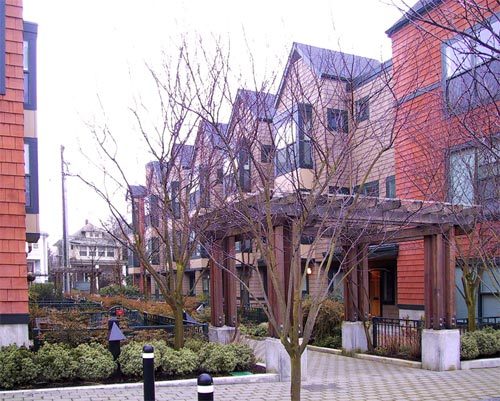
Well, that’s essentially the theme of this NY Times article titled “Europe Imagines Suburbs Without a Car.” While trying to make the content “fair and balanced” in a Fox News-ish sort of way, it’s impossible to escape the tone and tenor of the article suggesting that the Europeans are waaay ahead of us on this. They have a deeper commitment and projects on the ground.
While not a deep examination of the problems here in the US with suburban smart growth, the article does do a good job introducing some of the challenges facing American advocates (restrictive zoning, lenders worried about the true market rates of such homes, public inertia, etc). With Duval Patrick in MA having already suggested that future development should be clustered in high pedestrian and mass transit areas, it’s time for RI and all other neighboring states to push on this as well…
I personally believe that for such an effort to work here, advocates need to drop the idea of advocating that Americans give up their cars for mass transit, which to me screams “Oooh! Lets start a culture war!” and seems doomed to fail. I think the goal needs to be minimalizing auto use and making mass transit rational and convenient for more people (which is where Duval Patrick is right that future schools, retail, workplaces, etc should be clustered around transit nodes, not in the middle of nowhere). For those looking for who in RI to support on such suburban sustainability issues, the Scott Wolf led GrowSmartRI is a great place to start.



Transit nodes. Remind me to write you an article someday about the way they do things in South Korea. I was amazed. Everywhere, even in very small cities, it’s always the same pattern. Only the people occupied in agriculture live in low-density areas characterized by individual houses. For the rest of the population, it’s high-density residences in the form of clusters of apartment towers; parking usually hidden in garages underneath these complexes; schools, retail, and services built nearby so as to be in easy walking distance of these mini-cities; and great, dependable, regular mass-transit, usually in the form of buses, but in the bigger cities sometimes subways, to move people between different neighborhoods/development clusters. Intercity travel is most frequently provided by cheap, comfortable buses, but there’s also an extensive network for trains and high-speed trains, not to mention the airports.
That’s what happens when you try to accommodate nearly 50 million people in a country half the size of New England.
The attractiveness of the apartment towers often leaves something to be desired, but in a realistic modern world, it’s the most intelligent design I can imagine. Their plan still leaves an important place for motorvehicular transportation, but with less need for a car than we have in America, where you have to have a car to get anything or go anywhere. A car is simply less useful in their scheme.
Really interesting place to see. Of course the big cities have every transit option possible, but besides that difference the plan for their very small cities and very large cities is essentially the same: dense, urban, walkable. Of course, until the end of WWII, that’s the way it was in this country too: the urbanism in West Warwick was built on the same model as the urbanism in Boston, just on a smaller scale.
We need to find a way to get back to that.